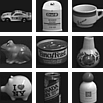3D Object Recognition
Recognition is achieved either by explicitly coding the recognition criteria in terms of low level structure, or through learning from examples. Learning algorithms incorporate subspace projections of higher dimensional data symbolically or using neural approaches.
Learning for Object Recognition
A learning algorithm accounting for the problem of object recognition is developed within the PAC (Probably Approximately Correct) model of learnability. We evaluate this apporach using the COIL-100 database and exhibit its advantages over conventional methods.
- M.-H. Yang, N. Ahuja and D. Roth, View-Based 3D Object Recognition Using SNoW, Proc. of the Fourth Asian Conference on Computer Vision, Vol. 2, Taipei, Jan. 2000, 830-835.
- D. Roth, N.-H. Yang and N. Ahuja, Learning to Recognize Objects, IEEE Int. Conference on Computer Vision and Pattern Recognition (CVPR), Vol. I, Hilton Head, SC, June 2000, 724-731.
- J. Weng, N. Ahuja and T. Huang, Learning, Recognition and Segmentation of 3-D Objects from 2-D Images, 4th Int. Conf. on Computer Vision, Berlin, Germany, May 11-14, 1993, 121-128.
